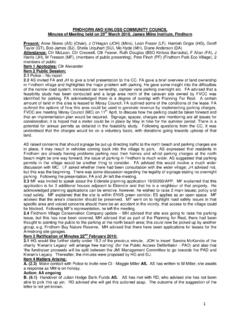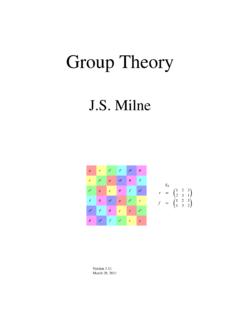Transcription of J.S. Milne
1 group MilneS3rD 1 2 32 3 1 fD 1 2 31 3 2 Version 17, 2017 The first version of these notes was written for a first-year graduate algebra course. As inmost such courses, the notes concentrated on abstract groups and, in particular, on finitegroups. However, it is not as abstract groups that most mathematicians encounter groups,but rather as algebraic groups, topological groups, or Lie groups, and it is not just the groupsthemselves that are of interest, but also their linear representations. It is my intention (oneday) to expand the notes to take account of this, and to produce a volume that, while stillmodest in size (c200 pages), will provide a more comprehensive introduction to group theoryfor beginning graduate students in mathematics, physics, and related information@misc{milneGT,author={ Milne , james S.}}
2 },title={ group theory ( )},year={2013},note={Available at },pages={127}}Please send comments and corrections to me at the address on my (August 21, 1996). First version on the web; 57 (August 29, 2003). Fixed many minor errors; numbering unchanged; 85 (September 1, 2007). Revised and expanded; 121 (May 17, 2008). Minor fixes and changes; 124 (September 21, 2009). Minor fixes; changed TeX styles; 127 (September 24, 2010). Many minor improvements; 131 (March 28, 2011). Minor additions; 135 (April 9, 2012). Minor fixes; 133 (March 15, 2013). Minor fixes; 133 (March 17, 2017). Minor fixes; 135 multiplication table ofS3on the front page was produced by group 1996 2017 paper copies for noncommercial personal use may be made without explicit permissionfrom the copyright Basic Definitions and Results7 Definitions and examples.
3 7 Multiplication tables ..11 Subgroups ..12 Groups of small order ..15 Homomorphisms ..16 Cosets ..17 Normal subgroups ..18 Kernels and quotients ..20 Theorems concerning homomorphisms ..21 Direct products ..23 Commutative groups ..25 The order ofab..28 Exercises ..292 Free Groups and Presentations; Coxeter Groups31 Free monoids ..31 Free groups ..32 Generators and relations ..35 Finitely presented groups ..37 Coxeter groups ..38 Exercises ..403 Automorphisms and Extensions43 Automorphisms of groups ..43 Characteristic subgroups ..45 Semidirect products ..46 Extensions of groups ..50 The H older program..52 Exercises ..534 Groups Acting on Sets57 Definition and examples ..57 Permutation groups ..64 The Todd-Coxeter algorithm.
4 70 Primitive actions..71 Exercises ..735 The Sylow Theorems; Applications753 The Sylow theorems ..75 Alternative approach to the Sylow theorems ..79 Examples ..80 Exercises ..836 Subnormal Series; Solvable and Nilpotent Groups85 Subnormal Series..85 Solvable groups ..88 Nilpotent groups ..91 Groups with operators ..94 Krull-Schmidt theorem ..96 Exercises ..977 Representations of Finite Groups99 Matrix representations ..99 Roots of1in fields .. 100 Linear representations .. 100 Maschke s theorem .. 101 The group algebra; semisimplicity .. 103 Semisimple modules .. 104 SimpleF-algebras and their modules .. 105 SemisimpleF-algebras and their modules .. 109 The representations ofG.. 111 The characters ofG.. 112 The character table of a group .
5 115 Examples .. 115 Exercises .. 115A Additional Exercises117B Solutions to the Exercises121C Two-Hour use the standard (Bourbaki) notations:NDf0;1;2;:::g;Zis the ring of integers;Qis the field of rational numbers;Ris the field of real numbers;Cis the field of complexnumbers;Fqis a finite field withqelements whereqis a power of a prime number. Inparticular,FpDZ=pZforpa prime integersmandn,mjnmeans thatmdividesn, ,n2mZ. Throughout the notes,pis a prime number, ,pD2;3;5;7;11;:::;1000000007;:::.Given an equivalence relation, denotes the equivalence class containing . The emptyset is denoted by;. The cardinality of a setSis denoted byjSj(sojSjis the number ofelements inSwhenSis finite). LetIandAbe sets; a family of elements ofAindexed byI, , is a functioni7!
6 AiWI! are required to have an identity element1, and homomorphisms of rings arerequired to take1to1. An elementaof a ring is a unit if it has an inverse (elementbsuchthatabD1 Dba). The identity element of a ring is required to act as1on a module overthe Y Xis a subset ofY(not necessarily proper);XdefDY Xis defined to beY, or equalsYby definition;X Y Xis isomorphic toY;X'Y XandYare canonically isomorphic (or there is a given or unique isomorphism);PREREQUISITESAn undergraduate abstract algebra ALGEBRA PROGRAMSGAP is an open source computer algebra program, emphasizing computational group get started with GAP, I recommend going to Alexander Hulpke s page here where you willfind versions of GAP for both Windows and Macs and a guide Abstract Algebra in GAP.
7 The Sage page here provides a front end for GAP and other programs. I also recommend s group Explorer here for exploring the structure of groups of small order. Earlierversions of these notes ( ) described how to use Maple for computations in group thank the following for providing corrections and comments for earlier versions of thesenotes: Acharya; Yunghyun Ahn; Tony Bruguier; Dustin Clausen; Beno t Claudon; KeithConrad; Demetres Christofides; Adam Glesser; Darij Grinberg; Sylvan Jacques; MartinKlazar; Mark Meckes; Victor Petrov; Diego Silvera; Efthymios Sofos; Dave Simpson;David Speyer; Robert Thompson; Bhupendra Nath Tiwari; Leandro Vendramin; , I have benefited from the posts to mathoverflow by Richard Borcherds, RobinChapman, Steve Dalton, Leonid Positselski, Noah Snyder, Richard Stanley, Qiaochu Yuan,and others (a reference monnnn a reference sxnnnn ).
8 1A family should be distinguished from a set. For example, iffis the functionZ!Z=3 Zsending aninteger to its equivalence class, a set with three elements family withan infinite index theory of groups of finite order may be said to date from the time of Cauchy. Tohim are due the first attempts at classification with a view to forming a theory from anumber of isolated facts. Galois introduced into the theory the exceedingly importantidea of a [normal] sub- group , and the corresponding division of groups into simpleand composite. Moreover, by shewing that to every equation of finite degree therecorresponds a group of finite order on which all the properties of the equation depend,Galois indicated how far reaching the applications of the theory might be, and therebycontributed greatly, if indirectly, to its subsequent additions were made, mainly by French mathematicians, during the middlepart of the [nineteenth] century.
9 The first connected exposition of the theory wasgiven in the third edition of M. Serret s Cours d Alg`ebre Sup erieure, which waspublished in 1866. This was followed in 1870 by M. Jordan s Trait e des substitutionset des equations alg ebriques. The greater part of M. Jordan s treatise is devoted to adevelopement of the ideas of Galois and to their application to the theory of considerable progress in the theory , as apart from its applications, was madetill the appearance in 1872 of Herr Sylow s memoir Th eor`emes sur les groupes desubstitutions in the fifth volume of theMathematische the date of thismemoir, but more especially in recent years, the theory has advanced Burnside, theory of Groups of Finite Order, introduced the concept of a normal subgroup in 1832, and Camille Jordan in thepreface to hisTrait e.
10 In 1870 flagged Galois distinction between groupes simplesand groupes compos ees as the most important dichotomy in the theory of permutationgroups. Moreover, in theTrait e, Jordan began building a database of finite simplegroups the alternating groups of degree at least5and most of the classical projectivelinear groups over fields of prime cardinality. Finally, in 1872, Ludwig Sylow publishedhis famous theorems on subgroups of prime power Solomon, Bull. Amer. Math. Soc., are the finite simple groups classifiable?It is unlikely that there is any easy reason why a classification is possible, unlesssomeone comes up with a completely new way to classify groups. One problem, atleast with the current methods of classification via centralizers of involutions, is thatevery simple group has to be tested to see if it leads to new simple groups containing itin the centralizer of an involution.


















